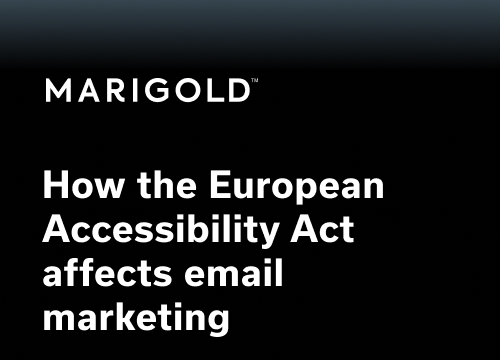Search is no longer the reliable traffic source it once was. As generative AI reshapes how people discover content, publishers are seeing shifts in the traffic they once took for granted.
The traditional “blue link” is evolving into AI overviews that answer users’ questions directly, pushing publisher content further down the page. According to The Wall Street Journal, some of the world’s largest publishers have reported traffic drops of 50% or more as Google rolls out its AI-powered search experience. Smaller publishers with tighter budgets, who depend even more on organic search, are feeling the impact even faster.
The shift may feel daunting, but it’s also accelerating a move many publishers were already making, to move away from borrowed traffic and toward durable, owned channels. And while AI is reshaping discovery, it also opens new opportunities for publishers who embrace it as part of their strategy.
Move beyond borrowed traffic
For years, publishers have adapted to changes in how audiences find content, from social algorithms to search rankings. SEO once softened the blow of those shifts, providing a dependable fallback when platforms deprioritized news.
AI is accelerating that evolution. Summaries and overviews are reducing the need for click-throughs, reminding us that the most durable strategies are those built on direct audience relationships.
Win in two arenas: AI answers and owned relationships
Building your own channels takes time, but don't overlook where people first find information: AI-generated summaries that now appear at the top of search results. These answers shape first impressions, and the brands that get cited there will still capture visibility even as clicks decline.
The goal is to be the source AI relies on, then convert that exposure into durable, direct relationships.
How to get featured in AI summaries
Put answers first. Start with a brief summary or key takeaways at the top of your content. Use subheadings that pose questions readers are asking.
Make your content easy for AI to read. Add structured data to your pages and clearly identify the author. This helps AI systems parse and trust your information.
Share original data. Publish unique statistics, explain your methods, and include simple charts. AI tools prioritize content they can quote.
Build credibility. Cite your sources and provide stable links or downloadable resources that others can reference.
Keep content current. Regularly update your most important pages and eliminate duplicate versions across your site.
Be consistent and track results. Use the same names, titles, and bios everywhere. Monitor which search queries trigger AI to feature your brand.
Once you’ve been cited, convert that visibility into owned relationships. Reinforce the takeaways across email, app, SMS, and web with real-time modules, capture preferences in the moment, and guide high-intent readers into subscription or membership flows. When AI features your content, you reach more people.
Double down on owned engagement
Rather than waiting for traffic patterns to stabilize, publishers are leaning into channels they own and audiences they can nurture directly. That means doubling down on email, launching branded apps, building communities, and experimenting with new revenue models like memberships, subscriptions, and events.
Email, in particular, continues to outperform every other channel, with 54% of consumers saying it drives purchases more than social or SMS, based on the 2025 Marigold Consumer Trends Index. Branded apps and communities diversify revenue and deepen loyalty. And as cookies recede, advertisers are looking for first-party data. Publishers who have loyal readers and useful data will do best in this new landscape.
Turn passive visits to active relationships
Before anything else, figure out who you're reaching and what they actually care about. Capturing real preferences, real engagement patterns, and real intent turns casual readers into loyal subscribers.
Interactive experiences like quizzes, polls, and preference centers give readers more control over how they engage, while also helping publishers gather the kind of zero- and first-party data that fuels personalization. Gamification and loyalty-style tactics, from exclusive content to point systems, are also emerging as powerful tools for keeping readers active and invested.
The payoff is more relevant content, more intentional journeys, and stronger monetization. Just as important, it aligns editorial and commercial goals: creating experiences readers want while giving advertisers better targeting.
How leading publishers are putting it into practice
Hearst UK boosted email conversion rates by up to 100% and saved more than 50 hours per month by streamlining newsletter creation and personalizing in real time. They achieved this by automating campaigns across 16 brands with Sailthru and Liveclicker, driving higher engagement with less effort.
Metro UK delivers personalized newsletters at scale that feel tailor-made for readers. Their horoscope email alone has a 45% open rate and 25% click-through rate, while newsletters like Football Daily and TV Daily perform even higher thanks to preference-based content blocks and automated journeys powered by Sailthru.
BBC Studios runs interactive campaigns across iconic brands like Doctor Who, Bluey, and BBC Earth to capture audience preferences and fuel personalization. With Marigold Grow, a single Doctor Who quiz generated over 84,000 views and 61,000 entries—data that now informs both content and CRM strategy.
The future belongs to owned
AI will continue to reshape how people discover and engage with content. It’s also influencing how content is created, distributed, and monetized. Regulation may eventually level the playing field, but waiting for that means potentially falling behind.
The publishers who succeed will build real relationships with their audience on their own platforms—using their own data, personalized content, and reliable revenue streams.
See how leading publishers are future-proofing their audience strategy with Marigold →






